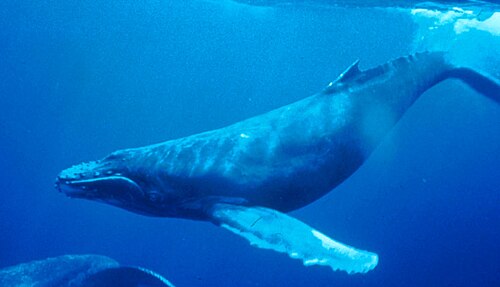Facts for Kids
Humpback whales are large marine mammals known for their long fins, acrobatics, and complex songs, found in oceans worldwide.
Overview
Feeding And Diet
Interesting Facts
Conservation Status
Cultural Significance
Habitat And Distribution
Physical Characteristics
Reproduction And Life Cycle
Behavior And Social Structure

Inside this Article
Literature
Pollution
Herring
Kingdom
Nature
Mother
Winter
Diving
White
Did you know?
🐋 Humpback whales can weigh up to 45 tons and grow up to 60 feet long.
🌊 They are known for their acrobatics, often breaching and slapping the water with their fins.
🎶 Humpback whales are famous for their complex songs, which can last up to 20 minutes.
🌍 These whales can be found in oceans all over the world, migrating up to 16,000 miles each year.
🍼 A female humpback whale typically gives birth to a single calf every two to three years.
🎣 They are unique among whales for their feeding technique called bubble net feeding.
🔊 Humpback whales can communicate across vast distances using low-frequency sounds.
🌱 They play a crucial role in ocean ecosystems by helping to regulate marine life populations.
🦈 Humpback whales have few natural predators, but orcas are known to prey on them.
🔥 During the mating season, males compete for females by singing and displaying their strength.
Introduction
Feeding And Diet
Interesting Facts
They can hold their breath for about 30 minutes while diving! They are also known for their acrobatic displays—sometimes they can do flips and spins in the air! Humpback whales are great teachers too; they can pass down songs to their young, which evolve over time. One unique fact is that each year, the songs change slightly, creating new versions! So, humpback whales are not just huge, but also talented singers of the sea!
Conservation Status
They are currently listed as "Least Concern" by the International Union for Conservation of Nature (IUCN). Organizations and experts work hard to protect their habitats from pollution and fishing nets. It's important for us to care for the oceans and help these majestic creatures thrive so future generations can enjoy seeing them in the wild!
Cultural Significance
Many people enjoy whale watching, where they can see humpbacks breach and sing. These magnificent whales also inspire art, literature, and songs around the world. Some stories depict them as protectors of the ocean, reminding us of the importance of caring for our planet and its creatures.
Habitat And Distribution
They are often found in warm tropical waters during winter, such as around Hawaii 🏝️ or the Caribbean. During the summer, they swim to colder regions near Alaska and Canada, where they can find plenty of food. Humpback whales love shallow coastal areas and deep ocean waters where they can dive and explore. They’re migratory animals, traveling thousands of miles between feeding and breeding grounds each year, making them some of the best travelers in the animal kingdom!
Physical Characteristics
Reproduction And Life Cycle
Behavior And Social Structure
Mothers typically stay with their calves (baby whales) for about a year, teaching them important survival skills and helping them learn the songs of their species.

